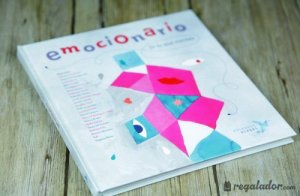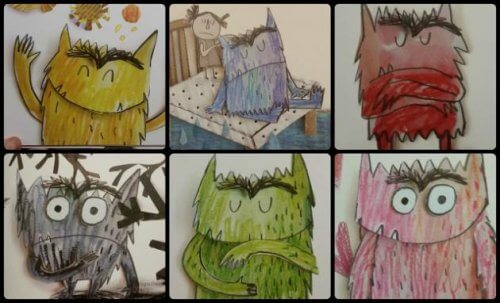Books to Help Your Child Deal with Emotions


Written and verified by the documentalist Arantza Martín Becerro
Helping children deal with emotions is often complicated because they don’t have the ability to express themselves like an adult yet. Books can be an excellent way to help children begin to understand what emotions and feelings are, how to manage them, and how to identify with them.
Nowadays, emotional education should be viewed as equally important to a child’s upbringing as more traditional subjects. This kind of education needs to be available in both classrooms and at home.
Reading and books can help familiarize children with emotions and feelings in a simple and easy-to-understand way, adapted to their maturity level and stage of development.
In this article, we present a selection of outstanding books to help your child deal with emotions. While sometimes complex, it’s essential to the development of their personalities.
Books to help children deal with emotions
1. Books for emotional education: The Color Monster
The success of The Color Monster confirms that it’s one of the best books for teaching children about emotions.
Many professionals in the worlds of education, library science and even psychology tout it as an essential book to assist in your child’s emotional education.

Monsters are always popular in children’s books, and here the main character teaches children about emotions through his own development, creating the following associations:
- Green means calm.
- Yellow means joy.
- Red means anger.
- Blue means sadness.
The book depicts emotions in a way that children can relate to their everyday lives, which will help them cope when these feelings arise.
2. Emotionary
Presented in the form of a dictionary, this is one of the best books to help kids deal with emotions. It includes an index featuring all the emotions that it describes in its pages. The Emotionary is a wonderful resource for when children have a hard time describing what they feel.
In addition, the book’s publisher, Palabras Aladas, offers supplementary material on its website to help work through each of the emotions contained in the book.
Emotionary is best suited for children over three as the illustrations make it easier for younger children to understand, and can reach kids as old as 12, who will understand each emotion more easily.
3. I Love You (Nearly Always)
As the title suggests, the theme of this book is love. The story doesn’t just focus on romantic love between couples, but also the kind shared among family and friends.
Acceptance and respect for others, embracing different perspectives, and the love you feel for those close to you are some of the topics you can explore with your little ones.
The illustrations in this book, as well as its pop-up version, will help your kids connect with this wonderful story and the kindness shown by its two main characters.
More books to help children deal with emotions
4. Otherwise
This book examines some of the more complicated feelings and emotions: goodbyes, missing people, sadness, and fear. The story follows a young girl as she learns how to transform these feelings into something else.

Recommended for children ages seven and up, the book’s beautiful illustrations help convey the character’s maturation process through several simple examples. This story can help change your little one’s perspective on the more difficult aspects of life.
5. Nacho’s Emotions
Very small children also need books to help them deal with their emotions, and this book is a terrific example. Using the most basic feelings as a foundation, the story’s main character expresses a series of emotions that kids will easily be able to identify.
What sets the book apart is that it uses the same narrative process for each emotion. This makes it easier for children to understand.
- First, the book describes the physical sensations produced by the emotion.
- Then, children can point out the illustrations they feel relate to that emotion.
- Finally, the emotion is featured in a short story starring Nacho.
In addition, the book includes educational activities to make for a more engaging experience, as well as fold-out pages.
Helping children deal with emotions is often complicated because they don’t have the ability to express themselves like an adult yet. Books can be an excellent way to help children begin to understand what emotions and feelings are, how to manage them, and how to identify with them.
Nowadays, emotional education should be viewed as equally important to a child’s upbringing as more traditional subjects. This kind of education needs to be available in both classrooms and at home.
Reading and books can help familiarize children with emotions and feelings in a simple and easy-to-understand way, adapted to their maturity level and stage of development.
In this article, we present a selection of outstanding books to help your child deal with emotions. While sometimes complex, it’s essential to the development of their personalities.
Books to help children deal with emotions
1. Books for emotional education: The Color Monster
The success of The Color Monster confirms that it’s one of the best books for teaching children about emotions.
Many professionals in the worlds of education, library science and even psychology tout it as an essential book to assist in your child’s emotional education.

Monsters are always popular in children’s books, and here the main character teaches children about emotions through his own development, creating the following associations:
- Green means calm.
- Yellow means joy.
- Red means anger.
- Blue means sadness.
The book depicts emotions in a way that children can relate to their everyday lives, which will help them cope when these feelings arise.
2. Emotionary
Presented in the form of a dictionary, this is one of the best books to help kids deal with emotions. It includes an index featuring all the emotions that it describes in its pages. The Emotionary is a wonderful resource for when children have a hard time describing what they feel.
In addition, the book’s publisher, Palabras Aladas, offers supplementary material on its website to help work through each of the emotions contained in the book.
Emotionary is best suited for children over three as the illustrations make it easier for younger children to understand, and can reach kids as old as 12, who will understand each emotion more easily.
3. I Love You (Nearly Always)
As the title suggests, the theme of this book is love. The story doesn’t just focus on romantic love between couples, but also the kind shared among family and friends.
Acceptance and respect for others, embracing different perspectives, and the love you feel for those close to you are some of the topics you can explore with your little ones.
The illustrations in this book, as well as its pop-up version, will help your kids connect with this wonderful story and the kindness shown by its two main characters.
More books to help children deal with emotions
4. Otherwise
This book examines some of the more complicated feelings and emotions: goodbyes, missing people, sadness, and fear. The story follows a young girl as she learns how to transform these feelings into something else.

Recommended for children ages seven and up, the book’s beautiful illustrations help convey the character’s maturation process through several simple examples. This story can help change your little one’s perspective on the more difficult aspects of life.
5. Nacho’s Emotions
Very small children also need books to help them deal with their emotions, and this book is a terrific example. Using the most basic feelings as a foundation, the story’s main character expresses a series of emotions that kids will easily be able to identify.
What sets the book apart is that it uses the same narrative process for each emotion. This makes it easier for children to understand.
- First, the book describes the physical sensations produced by the emotion.
- Then, children can point out the illustrations they feel relate to that emotion.
- Finally, the emotion is featured in a short story starring Nacho.
In addition, the book includes educational activities to make for a more engaging experience, as well as fold-out pages.
All cited sources were thoroughly reviewed by our team to ensure their quality, reliability, currency, and validity. The bibliography of this article was considered reliable and of academic or scientific accuracy.
- Cadarso, V. (2013). Abraza tu niño interior. España Madrid: Palmya. https://www.esferalibros.com/uploads/ficheros/libros/dossier-de-prensa/201304/dossier-de-prensa-dossier-abraza-a-tu-nino-interior-es.pdf
- Ciraolo, Simona (2018) Abrázame. Editorial SM
- Daywalt, Drew (2014) El día que los crayones renunciaron. Fondo de Cultura Económica
- Davies, Benji (2016) La ballena. Editorial Andana
- Díaz R., Raquel. (2017) ¿Qué le pasa a Uma? Editorial Nubeocho
- Dubuc, Marianne (2016) Lucía y sus amigos. Editorial Tramuntana
- Dueñas Buey, M. L. (2002). Importancia de la inteligencia emocional: un nuevo reto para la orientación educativa. http://e-spacio.uned.es/fez/eserv/bibliuned:EducacionXXI-2BB75B2C-720F-A542-4DCE-43297DDB55B7/Documento.pdf
- Gromaz, Elena. (2015) El lobo de los cuentos. Loto azul
- Gutiérrez, M. (2009). De otra manera. Thule Ediciones.
- Isern, Susanna. (2016) El ladrón de sonrisas. Editorial Infantil Amigos de papel
- Llenas, A. (2012). El monstruo de los colores. Editorial Flamboyant.
- Llenas, A. (2015). Te quiero (casi siempre). Editorial Espasa.
- McBratney, Sam (2018) Adivina cuánto te quiero. Ediciones KOKINOS
- Nuñez, C. (2013). El emocionario. Editorial Palabras Aladas.
- Quintero, Armando (2013). No hace falta la voz. Editorial OQO
- Sarah, Linda (2016) Grandes amigos. Editorial Andana
- Slegers, L. (2012). Las emociones de Nacho. Editorial Edelvives.
- Torrents, Montse. (2015) Los hilos invisibles. Editorial Tramuntana
- Waechter, Philip (2018) Yo. Editorial Lóguez.
This text is provided for informational purposes only and does not replace consultation with a professional. If in doubt, consult your specialist.








